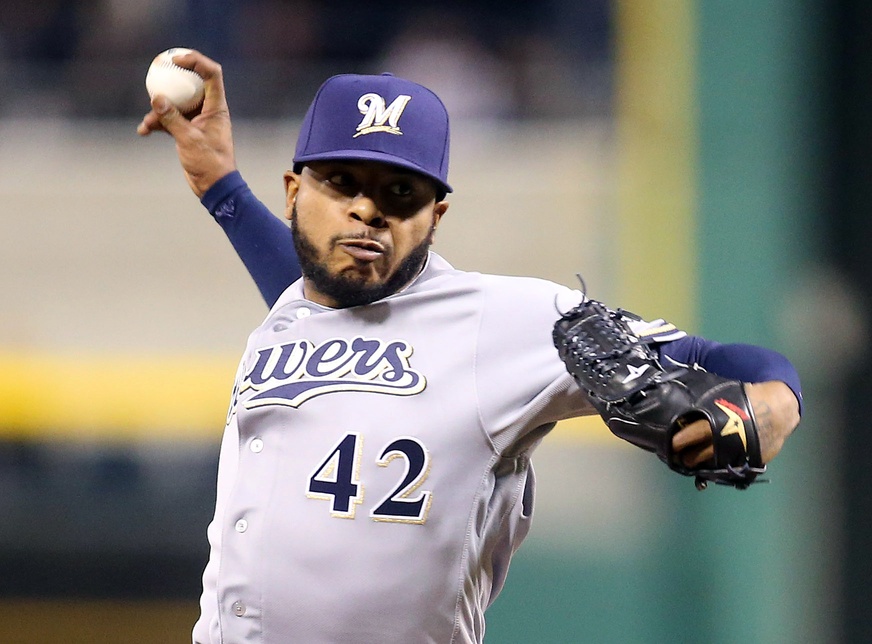During spring training, the Brewers’ stated plan was to use Will Smith and Jeremy Jeffress as co-closers. Manager Craig Counsell said that he would not be choosing either to be his Opening Day closer, and this logic made a certain amount of sense. Neither Jeffress nor Smith was a Proven Closer, but both were successful enough in 2015 (and, in Smith’s case, 2014) to earn a shot at the job.
But the most well-intentioned and thought-out plans do not always come through, and Smith’s LCL tear came at an inopportune time. Instead of being able to choose between two options, the Brewers were locked into using a single closer in a traditional way. And with Jeffress now being locked into the ninth inning, the Brewers lost some flexibility in the late innings as well.
This worked out fine, for the most part. The Brewers have a roughly middle-of-the-pack overall bullpen, and Jeffress has been solid. His 98 cFIP is right about average, and although the gap between his DRA (4.31) and ERA (2.36) indicates that he has been getting a bit lucky, his high ground ball rate helps him keep the ball in the stadium and perhaps make up some of that difference.
Now, though, Smith is back. From a competitive perspective, he is a welcome addition. The lefty was the best pitcher in the Brewers bullpen last year, so adding him to this group will clearly make the team better (assuming he is fully healthy). And once Smith is worked back into game shape, his presence will give the Brewers the option to go with co-closers if they so choose.
But will they? It was an excellent option in March. Without a true closer, the Brewers had the option to experiment with a more fluid bullpen and not limit their best reliever to just a single inning. Either Smith or Jeffress would have been available in high-pressure situations, and Counsell could have chosen either. The fact that one is right-handed and one is left-handed also helps: this would have given (or would give) Counsell even more flexibility.
Now, though, the situation is different. Jeffress is the sole closer, and he has been reasonably effective, going 15-of-16 in save chances and posting his aforementioned 2.36 ERA. Saves are obviously not the true measure of a closer’s effectiveness, and there are multiple metrics better at measuring a pitcher’s performance than ERA, but these types of numbers still rule late-inning decision-making. Pointing out that Smith has a longer track record of big league success than does Jeffress is important (and not that difficult to do, given their DRA gaps), but the politics of baseball make this distinction essentially irrelevant.
For some complicated multitude of reasons, baseball players and executives have decided that the ninth inning is different. For additional complicated reasons, this effectively means that once pitchers have proven that they can get the job done in the ninth inning, they are difficult to remove. And Jeffress has undoubtedly been successful at accumulating saves. His performance has not been as dominant as the Brewers would have liked, but the 15-of-16 ratio matters–both to Jeffress himself and very likely to his teammates. Removing him from the closer role and replacing him not with an established veteran but instead with a “committee” that he is a member of is simply not going to happen until or unless he struggles. Baseball players respect closers, and Jeffress has been an efficient one.
In terms of maximizing on-field value, this is not a great development for the Brewers. Having the chance to try out a co-closer setup was a golden opportunity. The organization is in a position to experiment, and if the arrangement had worked, they would have developed two valuable closer-quality relievers who would have been valuable either on the field or in a trade. Instead, they have been forced into a traditional setup. Sure, Jeffress may now bring back some additional trade value–if some team is fooled by his saves. And Smith is still a very good pitcher, and that still has value. But the Brewers lost their opportunity to experiment when Smith got hurt, and that chance isn’t likely to re-emerge during this season.
The primary reason this co-closer proposal was viable was that neither Smith nor Jeffress had any experience in the ninth inning, and that is simply no longer the case. Even if Smith returns to form and begins pitching just as well as Jeffress, the situation will never be the same as it was before this season, and that is a shame. For Jeffress to lose the ninth inning, he will have to struggle, which will at that point weigh on his resume just as heavily as his early-season success. Never again will he have this blank slate. And so, rather than have the opportunity to experiment, the Brewers are likely now locked into a more standard bullpen structure.
It’s important for me to note that this is not an ideal outcome. Instead, it is one that the modern baseball system itself has created, and I do not expect the Brewers to be the team to break this trend. The fact that there was a co-closer possibility at all suggests that maybe we are on the road to more fluid roles, but it does not appear as if we are there yet. The save statistic has created problems for the structure of many other bullpens, and it looks like it will do so for the Brewers as well.

1 comment on “What Does Will Smith’s Return Mean for the Bullpen?”